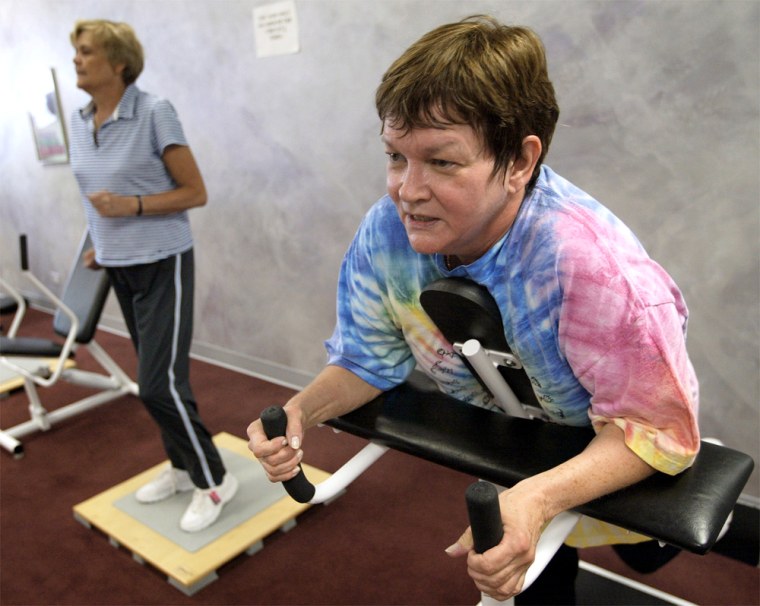Don’t have a lot of time to exercise at the gym? Maybe you could squeeze in a half-hour, or even a 15-minute, workout. That’s what health clubs are banking on as they increasingly offer clients “express” programs aimed at getting them in shape and out of the gym fast.
Largely driven by the success of Curves International, a chain of clubs for women that offers a 30-minute circuit program where the client moves from one fitness station to the next, other gyms have followed suit. For instance, 24 Hour Fitness, with clubs in 16 states, recently introduced Xpress Zone, a 30-minute circuit training program. And Town Sports International, with clubs in New York, Boston, Philadelphia and Washington, D.C., has a 22-minute circuit called XpressLine. Other new clubs built closely on the Curves model, like Ladies Workout Express and Slim and Tone, also are expanding.
Even traditional group classes like yoga and spinning that typically last an hour have been shortened at some clubs to anywhere from 30 to 45 minutes. And some gyms are offering 15-minute classes that focus on stretching or strengthening certain areas like the legs, abs or back.
A welcome trend
Not surprisingly, the trend toward less exercise is a welcome one to clients, industry sources say.
“The consumer is time-starved,” says John McCarthy, executive director of the International Health, Racquet and Sportsclub Association in Boston. The abbreviated programs are easier for many clients to squeeze into their tight schedules, he says.
"They get in and out quickly and get a really great workout at the same time," says Jeremy Smith, manager of fitness operations at 24 Hour Fitness, based in San Ramon, Calif.
Smith says organized circuit programs can be particularly helpful for people who don't have a lot of weight-training experience and who might otherwise come to the weight floor with a "deer-in-the-headlights look." Because they don't know how to begin, he says, they often give up on strength-training and head for the trusted treadmill instead.
While circuit programs started more than 15 years ago, McCarthy says, they were largely abandoned until recently, and now they’re coming back strong. Typically, the client works out on a series of weight machines aimed at hitting all the major muscle groups. In between sets, exercisers often perform cardio activities like jumping jacks or jogging in place. Some circuits incorporate short stints on a bike or treadmill, or use other equipment. The idea is to keep your heart rate up by not resting between sets.
Enough exercise?
But are express clients short-changing their health? Not necessarily, experts say.
A half an hour of daily physical activity is what’s recommended by the Surgeon General, so the 30-minute programs and classes can fit in, notes Barbara Bushman, an associate professor of health and physical education at Southwest Missouri State University in Springfield, and a spokesperson for the American College of Sports Medicine.
Since most people don’t get their half hour a day, shorter programs may be just what it takes to get some couch potatoes moving. And if they keep coming back for at least three months, they’re more likely to stick with the exercise habit, she says.
But that’s not to say that people who exercise longer than half an hour or at higher intensities won’t see additional benefits, Bushman points out. People with competitive goals, such as running a 5K or participating in a body-building event, are certainly going to need more intense training to get there.
And like any activity, express circuits may lead to boredom after awhile. Participants also could stop seeing results if they don't continually challenge themselves by gradually increasing the weights once their current settings have become too easy, experts say.
Mixing things up
As for the shorter group exercise classes, these not only appeal to time-pressed clients but also to those who simply become tired of the standard hour-long versions, says Jay Blahnik, a fitness instructor in Laguna Beach, Calif., who also works as an industry consultant and a spokesperson for IDEA, a trade group for fitness professionals.
"I think the hour class as a concept is on its way out," he says. "Thirty minutes just seems so much easier to swallow."
Plus, Blahnik says, someone who comes in for a full hour of yoga may not have enough time to also do other desired activities, such as weights or the treadmill. Shorter classes can allow a person to engage in a wider variety of cross-training activities while they're at the gym, he says. One could, for instance, take a half-hour yoga or Pilates class followed by a 30-minute circuit program, or a half-hour cycling class followed by a 15-minute stretch class, or follow that yoga class with 10 minutes on the treadmill.
In the end, all activity is good, so long as it's performed safely. "While it's certainly true that more exercise is better than some, some is certainly better than none," says Cedric Bryant, chief exercise physiologist for the American Council on Exercise in San Diego.
The main reason people don't exercise is their perceived lack of time, Bryant notes. So if shorter workouts get people to start exercising and to stick with it, "they're going to be profoundly impactful," he says.
"The 30-minute trend can really help to serve as a great launch point for a lot of people," he says.
